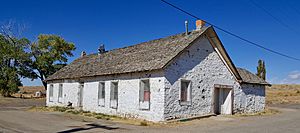Fort McDermit facts for kids
Quick facts for kids Fort McDermitt |
|
|---|---|
| Nevada (near McDermitt, Nevada) | |

Original building
|
|
| Type | Fort |
| Site information | |
| Controlled by | United States |
| Site history | |
| Built | 1866 |
| In use | 1865–1889 |
| Materials | adobe and stone |
| Battles/wars | Indian Wars |
Fort McDermit (also called Fort McDermitt) was an important U.S. Army fort located in Nevada. It was built to protect travelers and important routes during a time of conflict.
Contents
Fort McDermitt: A Nevada Stronghold
This fort was set up on August 14, 1865. It was first known as the "Quinn River Camp No. 33." Captain J. C. Doughty and his soldiers from the 2nd Regiment California Volunteer Cavalry established it. They were following orders from Lt. Col. Charles McDermit. The fort was located near the Quinn River.
Why Fort McDermitt Was Built
In the mid-1860s, there were attacks on white settlements and stagecoach routes. These events were part of what was known as the Snake War. To help protect people, the U.S. Army decided to place soldiers at a stagecoach stop called Quinn River Station. This station was on a key route between Winnemucca, Nevada and Silver City, Idaho Territory.
Lt. Col. Charles McDermit was ambushed and died on August 7, 1865, near the Quinn River. Because of his death and the ongoing unrest, the Army decided to build a stronger fort. They named the new fort "Fort McDermit" in his honor.
What Fort McDermitt Looked Like
Fort McDermit was designed to hold two companies of soldiers. This included both cavalry (soldiers on horseback) and infantry (soldiers who fight on foot). The fort was built around a large rectangular open area. This area was about 600 feet long and 285 feet wide.
Permanent buildings were constructed in 1866 and 1867. These included three buildings for officers and a large barracks for the soldiers. There was also a three-room hospital and storehouses. These storehouses held enough supplies to keep the fort running for six months. The fort also had stables for the horses. All these buildings surrounded the central square. They were one-story buildings with shingle roofs. They were made from adobe, stone, or wood. More wooden buildings were added in the late 1870s.
The fort's land was expanded on September 3, 1867. It became a two-mile square area. There was also a special hay reserve. This reserve stretched along the Quinn River for about 5 miles on each side. On October 4, 1870, this hay reserve was made even larger. It eventually covered over 10,000 acres.
Protecting Important Routes
Fort McDermit's main job was to protect important travel routes. This included the stagecoach and wagon road from Virginia City, Nevada to Boise, Idaho. It was the longest-serving Army fort in Nevada, operating for 24 years.
Soldiers from Fort McDermit took part in operations during the Snake War, the Bannock War, and the Modoc War. They helped protect settlers and travelers during these conflicts.
The Fort's Final Chapter
On July 24, 1889, Fort McDermit was the last active Army post in Nevada. It was then handed over to the Indian Service. The fort was changed and used as an Indian school. This school was located on the Fort McDermitt Indian Reservation.
Images for kids




